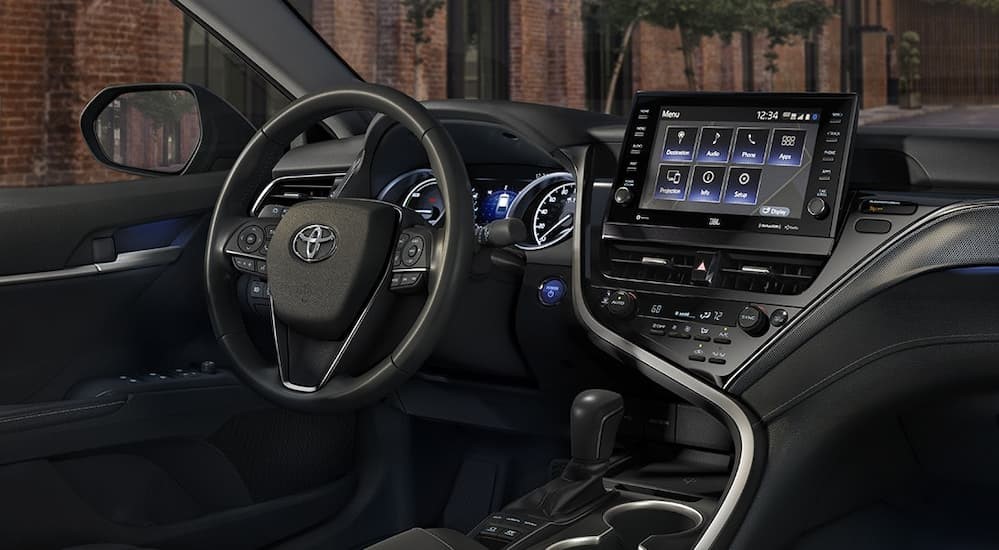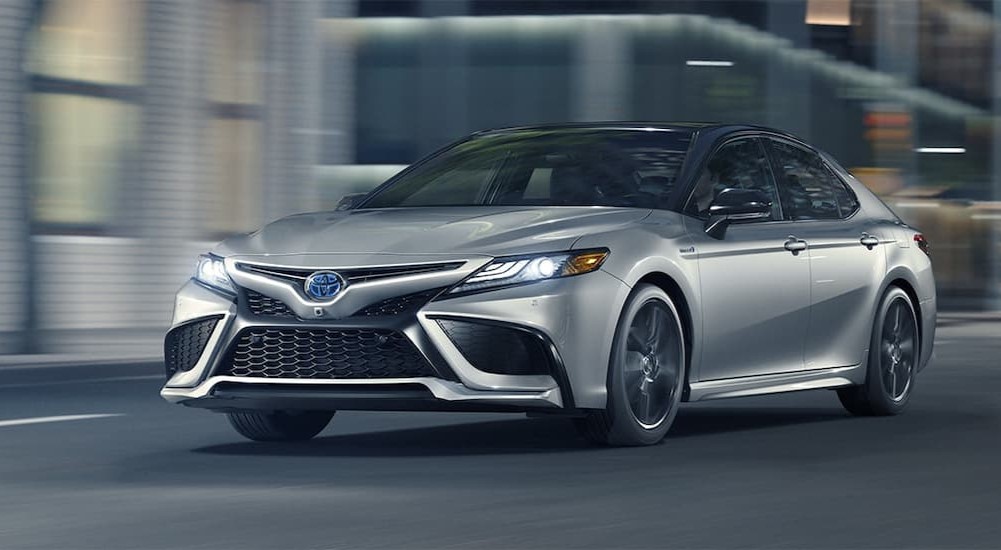There’s nothing sexy or glamorous about taking care of your vehicle, but all of the fun that comes with having a car—and all of the practical stuff, too—is only possible when your vehicle runs properly, which is where routine maintenance comes into play. Hybrids are no exception to this rule; there are a lot of great things about hybrid vehicles, but you still need to take care of them properly. If you have a Toyota hybrid, one of the easiest ways to care for it correctly is to take it to your preferred Toyota dealer for its routine care and scheduled service.
The trick to that, however, is to know what kind of service your vehicle needs and how often it needs it. Some people rely on reminders from their service shop or dealership for this, but it’s best to know what your vehicle needs and to stay on top of things yourself. This can help you get ahead of potential problems that can otherwise pop up, and it means you don’t have to worry about someone else remembering to care for your vehicle. So let’s take a look at the kind of service and maintenance you should be handling for your Toyota hybrid…
Hybrids vs Conventional Vehicles
Before going any further, we should dig into a few things that make hybrid models different from conventional gas-powered vehicles. As you probably know, a hybrid features a standard internal combustion engine and an electric motor (or two) powered by its own battery. Typical hybrid models recycle the kinetic energy produced by their movement to keep their battery charged, while plug-in hybrid electric vehicles (PHEVs) will have you plug the vehicle into an outlet to recharge their battery.
This is important because it changes a few things about how your vehicle drives and some of the steps you need to remember for maintenance. One nice difference is that hybrid models don’t need to have their oil changed as often as conventional cars since the battery and motor take some of the work off the engine’s shoulders. You’ll still want to look at the specific recommendation for oil changes for your vehicle, but it’s often less frequent than what someone with a standard car has to deal with.
Perhaps the biggest improvement for maintaining a hybrid is how long the brake pads or discs last compared to conventional vehicles. Hybrids typically utilize regenerative braking, which harnesses some of the energy of a vehicle in motion to charge the battery while slowing the car down. This isn’t enough to quickly stop a vehicle, so traditional brakes are still used, but regenerative braking reduces the abuse put on them. Brake pads and discs on a hybrid can last twice as long as those on a conventional vehicle thanks to regenerative braking—often 100,000 miles.

Recommended Service Schedule
No matter what kind of vehicle you have, the key to proper maintenance is always the same: follow the service schedule mandated by the manufacturer. This will typically be similar from one model to another, but there can be some important differences based on how a vehicle is made or the kind of engine you have. To illustrate what a service schedule for a Toyota hybrid can look like, let’s review what Toyota recommends for a 2021 Camry Hybrid, one of their most popular options.
At 5,000 Miles
The first service point for the Camry Hybrid is at 5,000 miles, and this is the interval that you’ll generally want to keep in mind. Once a Camry Hybrid hits 5,000 miles, Toyota says to rotate the tires, inspect the wiper blades, inspect or adjust all fluid levels, visually inspect your brake components, check the installation of the driver’s floor mat, and inspect the hybrid battery cooling intake filter.
That’s not too much, and you can quite easily do some of that yourself. A quick visit to a Toyota dealer or service center is all it takes to rotate the tires, inspect the brakes, and check the hybrid battery’s cooling system. Interestingly, this is basically identical to the standard Toyota Camry with the only difference being the inspection of the hybrid battery since you won’t find that on the non-hybrid model. You might also notice that Toyota only goes off of mileage and not timing the way a lot of other manufacturers do; you could have this service done about every six months if you’re not hitting that 5,000-mile point very often.

Every 10,000 Miles
The next big milestone comes at 10,000 miles, and this is going to be another common interval for maintaining a Toyota Camry Hybrid. The important thing to remember about a service schedule like this is that it repeats and builds on itself; the recommended service for this point is all the same stuff as the 5,000-mile service visit, plus replacing the engine oil, oil filter, and cabin air filter.
This essentially repeats every 10,000 miles as long as it doesn’t coincide with what needs to be done every 15,000 miles or at the 30k, 60k, etc. mileage markers. And yes, this means you only need to worry about an oil change every 10,000 miles with a Toyota Camry Hybrid, assuming all else is working properly. As I said before, that hybrid design helps take a load off the engine, and your motor oil will last longer than you might expect.
Every 15,000 Miles
Here’s the biggest milestone you should pay attention to; while you certainly don’t want to ignore either of the previous two, this one has a lot more that needs to be done. In addition to the basic stuff at 5,000 miles, service at this point should include inspections of your ball joints and dust covers, brake lines and hoses, steering gear, steering linkage and boots, drive shaft boots, engine/inverter coolant, exhaust pipes and mountings, and the radiator, condenser, and intercooler.
As you can see, the majority of this visit comes down to a thorough inspection of your Toyota. Of course, if there are any issues found with the steering gears, brake lines, exhaust, or anything else, then you’ll need to have additional work done to fix such problems. This can make 15k a much bigger milestone than it might seem at first, but it’s better to have something found during an inspection and solved before it becomes a much larger issue that costs a lot more to fix down the road.

Additional Service Considerations
For the most part, the aforementioned mileage markers repeat, and you’ll have the same work done at each point; for example, when your Toyota hybrid hits 20,000 miles, you’ll need to have the same stuff done as when it was at 10,000 miles. There are some exceptions to this at certain points; for example, at 30,000 miles, you’ll need to have the 15k stuff done that we looked at, along with having other parts like the transmission, fuel tank gas cap, and fuel lines checked—plus the 10k stuff like an oil change. That can be a lot to keep track of, which is why it’s important to adhere to the schedule set by the automaker.
One other key thing to remember is that your driving habits can impact how often you’ll need to have certain things done. If you have a Toyota Prius Prime—a PHEV with a towing capacity of 1,500 lbs—and you tend to do some towing with it, then you should change your engine oil every 5k miles instead due to the added strain this puts on your vehicle’s engine. Similarly, if you make a lot of short trips in cold weather, spend a lot of time idling and driving at low speeds (like using your Toyota as a delivery vehicle), or drive on a lot of dusty or dirt roads, then you may need to replace your oil and filters more often.
Get the Most From Your Toyota Hybrid With Proper Maintenance
The good news is that proper care and maintenance for your vehicle isn’t particularly difficult, and it’s often a quick thing that can be done with a short visit to your favorite Toyota dealer or service center. The better news is that following this schedule will help you avoid future problems that can cost you a lot more time and money than routine service. Just be sure to know and follow your vehicle’s service schedule and be aware of the added strain you put on your car so you can adjust things accordingly.
Oh, and if you have a PHEV like the Prius Prime, be sure to plug your vehicle in frequently to keep it charged for the best performance and longevity. This will keep your Toyota running beautifully and ensure you can keep getting the most from it for many years to come.

